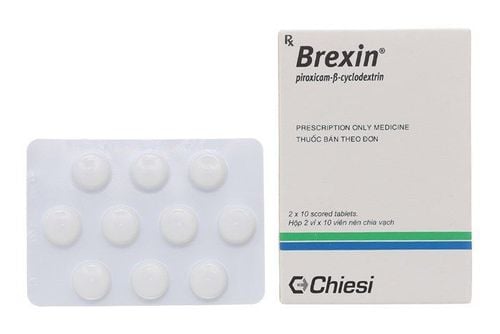This is an automatically translated article.
Magrax has a good therapeutic effect on joint diseases such as rheumatoid arthritis, gout or spondylitis and is used in dental surgery. So what is Magrax etoricoxib 90mg?
1. Effects of the drug Magrax
The main ingredient of Magrax is etoricoxib. The active ingredient etoricoxib belongs to a class of selective COX-2 inhibitors and to the group of non-steroidal anti-inflammatory drugs (NSAIDs). The mechanism of Magrax drug is that when there is inflammation, high COX-2 concentrations in inflammatory tissues lead to the synthesis of Prostaglandin - a mediator of pain and inflammation. Etoricoxib is a cyclooxygenase (COX-2) inhibitor that is selective at therapeutic concentrations, thereby reducing prostaglandin levels, which are mediators of pain and inflammation. In clinical pharmacology studies, etoricoxib inhibited COX-2 in a dose-dependent manner without inhibiting COX-1 at doses up to 150 mg/day.Magrax is used for:
Acute and chronic treatment of signs and symptoms of osteoarthritis such as osteoarthritis, rheumatoid arthritis, ankylosing spondylitis and gout; Treatment of ankylosing spondylitis; Treatment of acute gouty arthritis; Relief of acute and chronic pain; Short-term treatment of moderate pain following dental procedures; Treatment of primary dysmenorrhea.
2. Instructions for using the drug Magrax
2.1 How to use Magrax medicine Magrax etoricoxib 90mg is taken orally and can be taken with or without food. The initial effect may be faster when Magrax etoricoxib 90mg is taken without food. This should be considered when you need to quickly reduce symptoms of the disease.
2.2. Dosage of Magrax Since the cardiovascular risk of Magrax may increase with dose and duration of exposure, the shortest duration and lowest effective daily dose should be used.
The need to treat the symptoms of the disease and the response to treatment should be re-evaluated periodically, especially in patients with osteoarthritis.
For rheumatoid arthritis, ankylosing spondylitis The recommended dose is 60mg x 1 time/day. In some people with treatment that does not relieve symptoms, increase the dose to 90mg once daily. When symptoms have stabilized, a dose reduction of 60 mg once daily may be appropriate. If treatment is not effective, your doctor will consider other treatment options.
Acute Pain For acute pain, Magrax should only be used for the acute symptomatic period.
Acute gouty arthritis The recommended dose is 120mg/time/day. In clinical trials for the treatment of acute gouty arthritis, Magrax was administered for 8 days.
Pain after dental procedures The recommended dose is 90mg / time / day, using Magrax for a maximum of 3 days. Some people may need postoperative pain relief in addition to etoricoxib during this 3rd period of treatment.
2.3. In case of overdose, missed dose of Magrax When you have an overdose, you need to immediately go to medical facilities for timely monitoring and treatment. Doctors will carry out the usual treatment measures such as removing unabsorbed drug from the gastrointestinal tract, clinical monitoring and supportive treatment if necessary. Hemodialysis does not remove the etoricoxib component. Currently, the effectiveness of drug removal from the body by peritoneal dialysis is unknown.
When you miss a dose, take your Magrax as soon as possible. However, if the time interval for the missed dose is close to the next dose, skip the missed dose and take your next dose at the scheduled time. Absolutely, do not take Magrax twice the prescribed dose.
3. Side effects of the drug Magrax
When using the drug Magrax may appear unwanted effects. Some undesirable side effects are commonly encountered in clinical practice such as:
Stomach pain; Dry socket (pain and inflammation after tooth extraction); Swelling in the legs and feet caused by water retention; Dizziness, headache; Palpitations (caused by fast or irregular heartbeat), arrhythmia; Hypertension ; Wheezing or shortness of breath (due to bronchospasm); Digestive disorders: constipation, flatulence, heartburn, diarrhea, dyspepsia, nausea, vomiting, esophagitis, mouth ulcers; Changes in blood tests related to liver function; Bruising on the skin; Weakness and fatigue, flu-like illness. Uncommon side effects:
Gastric ulcer; Upper respiratory tract infection or urinary tract infection; Changes in laboratory indicators (decreased in the number of red blood cells, white blood cells, platelets); Hypersensitivity reactions due to allergies, urticaria; Changes in appetite, uncontrolled weight gain; Psychiatric disorders: anxiety, depression, reduced mental clarity, hallucinations; Inability to sleep, tingling sensation, drowsiness; Blurred vision, discomfort, or red eyes; Tinnitus, dizziness, feeling of rotation when standing still; irregular heartbeat (such as atrial fibrillation), fast heart rate, heart failure, feeling of chest pain, pressure or heaviness in the chest (angina), heart attack; flushing, stroke, hypertension, vasculitis; Cough, difficulty breathing, nosebleed; Changes in bowel movements, peptic ulcer, gastritis, dry mouth may become worse; If during the use of Magrax, there are any adverse effects, please inform the treating doctor or pharmacist for appropriate treatment.
4. Magrax drug interactions
In order to increase the effectiveness of the drug as well as minimize unwanted side effects, patients should not combine Magrax with the following drugs:
Anticoagulants such as Warfarin: Caused by increased time of Prothrombin. Diuretics and antihypertensives: Because when combined with Magrax, the effect of these drugs is reduced. Acetylsalicylic Acid: Possible cause of increased risk of peptic ulcers. Lithium: Because when combined with the drug Magrax increases the concentration of lithium in the blood plasma. Methotrexate: You should be fully tested for toxicity when combining these two drugs. Ciclosporin or Tacrolimus (drugs that suppress the immune system): Increased nephrotoxic effect. Digoxin: May increase peak digoxin concentrations. Salbutamol (asthma medication): Because when combined with the drug Magrax reduces the effect of this drug due to antagonism. Birth control pills: Because when combined with Magrax can increase the risk of unwanted effects. Hormone replacement therapy: The combination of Magrax in the treatment of disease may increase the risk of side effects. Aspirin: Concurrent use of Magrax may increase the risk of stomach ulcers when used together.
5. Some notes when using Magrax
5.1. Contraindications when taking Magrax Drugs People who are sensitive or allergic to any of the ingredients of Magrax; Have a stomach ulcer or gastrointestinal bleeding; Severe liver failure; Severe renal failure (ClCr < 30ml/min); History of asthma, acute rhinitis, nasal polyposis, angioedema, urticaria when taking aspirin or NSAID; Women who are pregnant or breastfeeding; Children under 16 years old; Cystitis ; Severe congestive heart failure; People with a history of urticaria, allergies, bronchospasm, acute rhinitis... After using NSAIDs including selective COX-2 inhibitors; People with hypertension with a blood pressure value of 140/90 mmHg or higher that is not well controlled by medication; Have an inflammatory bowel disease. 5.2. Magrax should be used with caution in patients with ischemic heart disease, renal failure, cirrhosis of the liver, heart failure, left ventricular dysfunction, hypertension, at risk of edema, the elderly. , dehydration. Keep Magrax out of reach of children and household pets. Ability to drive and use machines: When using Magrax, you may experience dizziness, lightheadedness or drowsiness when taking the drug. Do not drive or operate machinery. Pregnancy: There are no clinical data on the use of etoricoxib during pregnancy. Studies performed in animals indicate a potential for reproductive toxicity. The potential risk to pregnant women is unknown. Magrax, similar to other prostaglandin synthesis inhibitors, can cause decreased uterine contractility and premature closure of the ductus arteriosus during the third trimester of pregnancy. The use of etoricoxib is contraindicated during pregnancy. If you are pregnant and become pregnant while taking the drug, it is necessary to stop etoricoxib. Lactation: There have been no studies on whether etoricoxib is excreted in breast milk. Etoricoxib is excreted in milk in rats. You should not breast-feed while using Magrax. Fertility: Etoricoxib, like COX-2 inhibitors, is not recommended for use in women trying to get pregnant. In summary, whether or not Magrax is effective depends on the subject as well as compliance with the safe use of the drug. Therefore, patients should carefully read the instructions or follow the instructions of the treating doctor when taking the drug.
Please dial HOTLINE for more information or register for an appointment HERE. Download MyVinmec app to make appointments faster and to manage your bookings easily.













